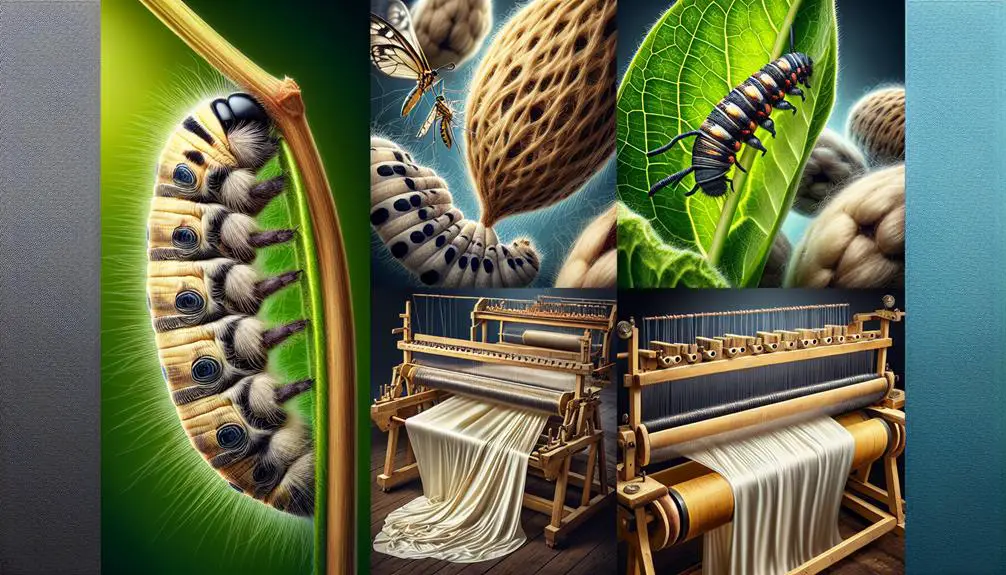Silk, originating from ancient China, begins with silk worms spinning cocoons for threads. Mulberry silk worms are the source. The United States leads in silk imports. Silk is hypoallergenic and antimicrobial due to sericin. It's the strongest natural textile, surpassing metal wire strength. Also, it's ideal for temperature regulation, offering warmth or coolness. Silk's tightly woven fibers repel insects, creating a protective shield. These facts merely scratch the surface of silk's fascinating qualities.
Table of Contents
Key Takeaways
- Silk production originated in ancient China around 3630 BC.
- Silk is hypoallergenic and has antimicrobial properties.
- Silk is the strongest natural textile, even stronger than metal wire.
- Silk regulates body temperature, providing warmth in winter and cooling in summer.
- Silk's tightly woven fabric acts as a natural shield against insects.
Silks Ancient Origins and Production
Silk's ancient origins date back to around 3630 BC in China, where its production began. The silk industry flourished in Ancient China, with mulberry silk worms being the source of this luxurious fabric. These worms spin cocoons, which are then harvested to extract the fine threads that make up silk.
Despite its prestigious status, silk holds less than a 0.2% share in the global textile fiber market, partly due to its higher raw silk price compared to materials like cotton. Remarkably, the United States stands out as the largest silk importer worldwide, showcasing the continued demand for this exquisite material.
Understanding the historical significance of silk in Ancient China sheds light on its enduring appeal and the intricate process behind its production.
Silks Hypoallergenic and Antimicrobial Properties
Exploring silk's essential and notably properties reveals its unique benefits for sensitive skin and overall health. Silk, known for being hypoallergenic, is a safe choice for individuals with sensitive skin, as it reduces skin irritation and allergic reactions. This natural fabric contains sericin filaments that possess antimicrobial properties, effectively repelling dust mites and preventing bacteria growth.
Silk pillowcases, in particular, can enhance sleep quality by minimizing skin irritation and allergies, promoting a comfortable and restful night's sleep. Additionally, silk's breathable nature not only provides comfort but also contributes to its resistance to allergens. The sericin present in silk fibers plays a vital role in maintaining hygiene by inhibiting the growth of bacteria.
Embracing silk as a bedding and clothing option can notably benefit those seeking a hypoallergenic, antimicrobial, and breathable fabric that supports skin health and overall well-being.
Silks Strength and Textile Superiority
With unparalleled strength and textile superiority, silk stands out as a remarkable natural fabric in various aspects.
Silk's strength surpasses that of materials like Kevlar, making it the strongest natural textile. This strength is evident in silk rope, which is known to be stronger than an equally thick metal wire, showcasing its exceptional durability. Additionally, silk fabric acts as an impenetrable barrier against insects, providing protection against mosquitoes.
The thermal insulation properties of silk come from the unique structure of silkworm cocoons, offering warmth in winter and coolness in summer. Furthermore, silk blankets contain essential amino acids that contribute to skin health by helping prevent wrinkles. These amino acids make silk blankets not only cozy but also beneficial for maintaining skin's youthfulness.
To conclude, silk's combination of strength, thermal insulation, and skin health benefits solidify its position as a superior natural textile.
Silks Temperature Regulation and Insulation
Temperature regulation and insulation are key characteristics that set silk apart as a versatile and comfortable fabric choice for all seasons. Silk's natural ability to keep the body cool in summer and warm in winter makes it ideal for various climates. The fabric's thermal insulation properties, derived from silkworm cocoons, provide comfort by adjusting to the body's temperature. Silk's insulating feature not only retains body heat but also contributes to its reputation for coziness. This adaptability to different temperatures showcases silk's versatility and makes it a preferred fabric choice for those seeking comfort year-round.
| Temperature Regulation | Insulation | Comfort |
|---|---|---|
| Cool in summer | Warm in winter | Body heat retention |
Silks Unique Insect-Repellent Characteristics
Silk's tightly woven fabric acts as a natural shield against insects, providing a repellent barrier due to its dense and impenetrable structure. The fine fibers of silk make it challenging for insects like mosquitoes to penetrate, offering a bug-free environment. Insects are unable to bite through silk due to its dense weave pattern, preventing them from infiltrating the fabric.
Additionally, silk's unique properties extend to repelling dust mites and other allergens, making it a preferred choice for individuals with sensitivities. The dense fibers of silk create a barrier that insects find difficult to breach, ensuring a protective layer against unwanted pests.
This insect-repellent characteristic of silk showcases its versatility beyond being just a luxurious fabric, making it a practical choice for those seeking a natural defense against insects and allergens in their surroundings.
Frequently Asked Questions
What Are 3 Facts About Silk?
Three facts about silk include its origin in Ancient China, hypoallergenic properties suitable for sensitive skin, and minimal market share globally. It's a natural protein fiber from silkworm cocoons, with the US as a major importer.
What Are 5 Characteristics of Silk?
Silk's characteristics include being hypoallergenic, antimicrobial, strong like Kevlar, temperature-regulating for year-round comfort, and insect-repellent. Its amino acids can benefit skin health by preventing wrinkles. These qualities make silk a versatile and beneficial fabric.
What Are the 10 Uses of Silk?
Silk serves various purposes, including formal attire, luxurious bedding, medical sutures, parachute threads, and high-end rugs. Its strength, hypoallergenic nature, and lightweight properties make it versatile for different applications, combining luxury with functionality.
What Made Silk so Special?
Silk's uniqueness stems from its hypoallergenic, antimicrobial, and temperature-regulating properties. The intricate production process, strength surpassing Kevlar, and China's historical monopoly all contribute to making silk a fabric like no other.
- How Does Ring Spun Cotton Affect Garment Fit and Shape Retention? - August 13, 2024
- What Are the Challenges in Producing Ring Spun Cotton? - August 13, 2024
- Is Ring Spun Cotton Suitable for Plus-Size Clothing? - August 13, 2024




